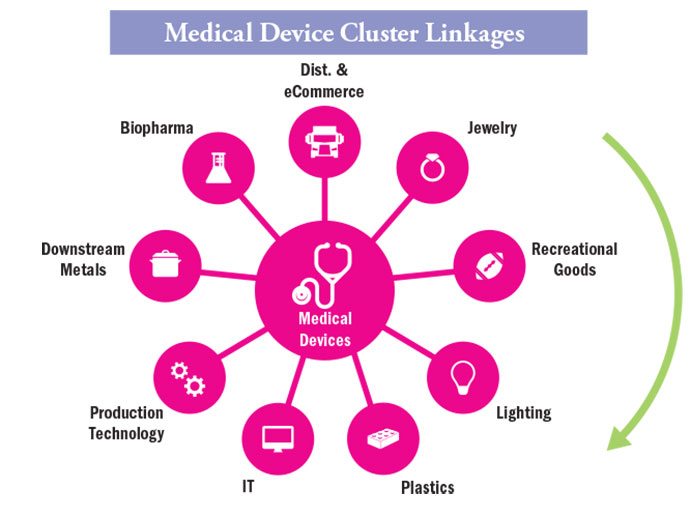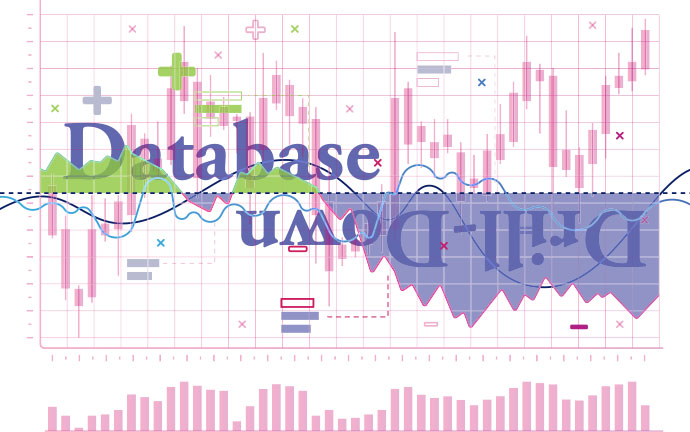Use these analytics tools to navigate to where the action is.
Findings from Conway Analytics’ proprietary corporate projects database; the DataUSA project from Deloitte and MIT; and Harvard’s U.S. Cluster Mapping initiative show where medical device and technology companies, projects and jobs have the strongest profiles — and where the strongest opportunities may emerge in the years to come.
Looking back over four years of data, Conway’s numbers show the United States leads by a long shot. But ample project activity is afoot in the UK, China, Ireland, Costa Rica, Mexico and Germany.
The latest project to land in Costa Rica came in October, when Edwards Lifesciences announced it will invest $100 million and add 500 new jobs at a new facility in La Lima Industrial Park in Cartago, where the total payroll will reach 1,100 when that hiring is complete by the end of 2020. The company will continue to focus on the manufacture of cardiac implantable products. Edwards established operations in Costa Rica in 2016. CINDE Managing Director Jorge Sequeira noted how companies such as Edwards continue to take advantage of his country’s talent ecosystem, specifically through working with the National Institute for Learning (INA, for its acronym in Spanish) to train operational, technical, and specialized workers.
"This is how the sector has become one of the most dynamic in our economy," he said, where medical technologies contributed more than $3.3 billion million in 2018 as Costa Rica’s main export product. The sector already generates about 30,000 quality jobs, with 55% going to women.
Conway Analytics data show that leading medical device territories in the U.S. are the usual suspects: Minnesota, Indiana, Massachusetts, Ohio, North Carolina, Florida and California. At the regional level, the project data — which seeks to track every corporate facility investment in the sector that involves at least $1 million invested, 20 new jobs created or 20,000 new sq. ft. of space — show device clusters ticking along in such regions as Greater Chicago; San Jose-Heredia and Tijuana, Mexico; Memphis; Suzhou, China; Atlanta; Cleveland; and Galway, Ireland.
A collaboration among Deloitte, MIT Media Lab’s Collective Learning Group and Datawheel, Data USA, launched in spring 2016, combines publicly accessible U.S. government data from a variety of statistical agencies (and nearly 200,000 publicly available data sets) and brings it to life in more than 2 million visualizations.

Among the information you can glean and dissect at datausa.io, the locations with the highest concentration of employees in the industry group are Kosciusko and Marshall Counties in Indiana (i.e. the medical device capital of Warsaw); the San Juan-Carolina-Toa Baja & Dorado region of Puerto Rico; and the the Minneapolis-St. Paul suburbs.
I talked to Ann Perrin, the senior research executive with Deloitte Services LP who co-leads DataUSA and who launched Deloitte Research in 1996; and Pedro Arboleda, a managing director in Deloitte’s consulting practice who worked with industry cluster pioneer Michael Porter while at Monitor Group and helped develop the Cluster Mapping Project at Harvard. But his primary job is working with companies on market entry strategy, manufacturing configurations and productivity.
Asked how those companies have responded in the wake of Puerto Rico’s hurricane disasters, he says from what he hears throughout the supplier base, “the companies felt a real responsibility for picking up from where they were before. So I haven’t seen any massive shift out of Puerto Rico. It was embedded into the cost of doing business.”
As for Latin America in general, “you are seeing a lot of shared services centers in Colombia,” he says, in addition to traditional device manufacturing clusters in Costa Rica, Puerto Rico and the Mexican maquiladoras. “Medtronic just opened a big center in Bogota, an incredible facility with back-office functions. They chose Bogota over other places traditionally on the map like San Jose, Costa Rica. Places like Colombia are competing very well. The feedback we’ve heard is it’s very competitive with high-quality employees, and it’s still lower cost than Chile or Argentina.”
China is of particular interest because the People’s Republic seeks to boost its national champions in the medical device field just as it has in other sectors.

“That’s a big market, and chronic diseases are on the rise and in some cases surpassing the rates of other developed economies,” he says. At the same time, “people are living longer, so that has created the need for more medical devices, which creates a need for more local medical device manufacturers.”
China also has set strict cybersecurity and data privacy regulations. The new European medical device regulation (MDR) is coming online, and others are popping up in different countries and even states such as California.
“A couple of these regulations are coming online quickly, in January,” Arboleda says. “It might mean locating people in those countries so they’re closer to the regulators.”
Going Digital
Arboleda says many medtech firms are heading to Silicon Valley because “the software wrap around the hardware is essential to creating the final offering, and they need to be closer to where the software experts are.”
Google’s Deep Mind unit is part of a lot of use cases now, Arboleda says. Apple created an app for Zimmer Biomet. For some firms, this might mean a shift of talent — including in the opposite direction from the trend.

“Google announced recently they will be a partner of choice for Mayo Clinic, a world leader,” he says. “Google will relocate their data scientists, sending all of these engineers from Mountain View to Rochester, Minnesota. You’re going to see more and more of these pairings.”
That also means tracking university research. Ann Perrin says the latest launch of DataUSA includes a new feature called VizBuilder that includes data from around 7,500 universities. A look at any project short list will likely include affiliations with schools such as MIT, Rice or Stanford, or major medical centers. Houston benefits from the presence of Texas Medical Center, as well as “family offices” — foundations and other family-backed organizations that have begun to invest in medtech.
Which sectors will medical devices pair up with next? Arboleda sees potential in smart apparel (thus an opportunity for textile strongholds); and in automotive and aerospace, because humans are captive subjects for diagnostics while they’re occupying cars and aircraft.
“Will Detroit have a medical device industry? Well, an offshoot of it, yes, I think so,” Arboleda says. “Could you provide a checkup for people who are flying? These are the kinds of things to think about.”

